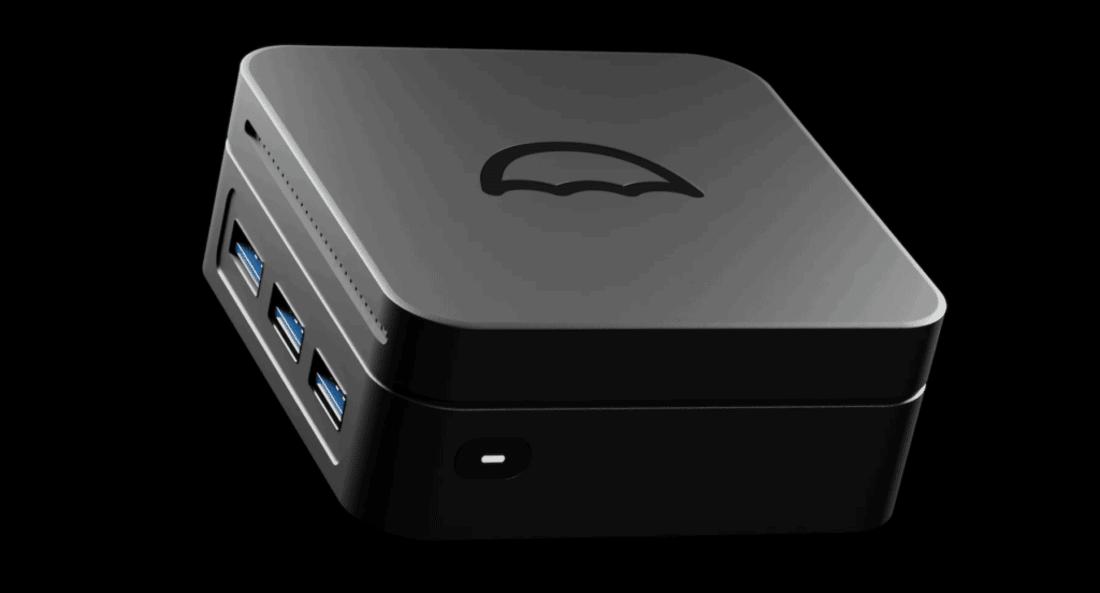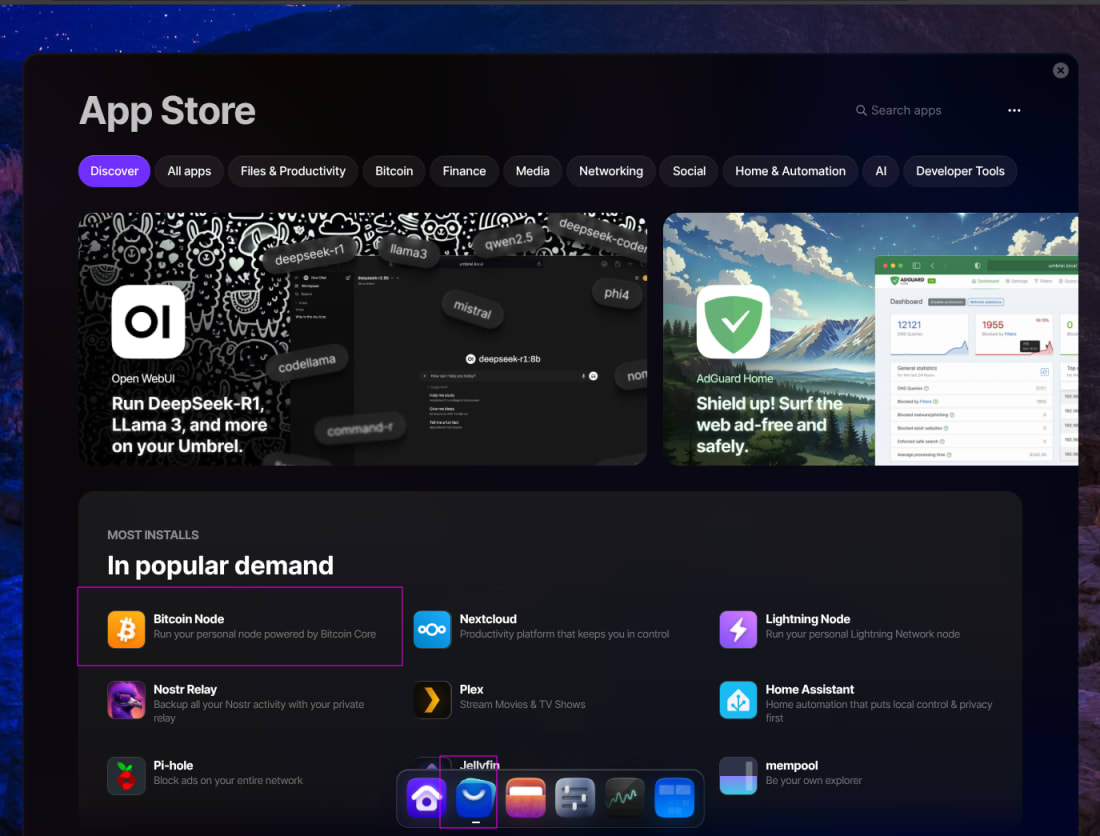
How to run a Bitcoin Node with Umbrel Home
The ultimate plug and play home server to run a Bitcoin Node
In the world of Bitcoin, running your own node can provide numerous benefits, including enhanced privacy, security, and a deeper understanding of the network by enabling you to interact directly with the Bitcoin network without relying on third-party services. Having direct connection reduces the risk of surveillance and ensures that your transactions are processed independently.
An additional benefit of running a node, is that you contribute to the overall health and decentralisation of the Bitcoin network, supporting its resilience against attacks and censorship. You gain the ability to independently verify transactions and blocks, ensuring the integrity of the blockchain data you receive. This independence also means you are less susceptible to network outages or performance issues experienced by centralised services.
The fun part of running a node is that it can be a rewarding educational experience, deepening your understanding of how the Bitcoin network operates and fostering a greater appreciation for the technology behind it.
Why Run a Bitcoin Node?
Running a Bitcoin node offers several advantages:
- Enhanced Privacy: By connecting directly to the Bitcoin network, you can avoid relying on third-party services, reducing the risk of surveillance and censorship.
- Network Support: Your node contributes to the overall health and security of the Bitcoin network by verifying transactions and blocks.
- Independent Verification: You can independently verify transactions and blocks, ensuring that the information you receive is accurate and unaltered.
- Decreased Reliance on Third-Parties: Running your own node reduces dependence on centralised services, giving you more control over your Bitcoin experience.
Getting started with running a Bitcoin node has been made easier by a number of great platforms and tools that have subsequently made their way to the market over the years.
One of the most user-friendly ways to set up a Bitcoin node is by using Umbrel, a powerful and intuitive platform that simplifies the process. The Umbrel Home has become my preferred way to run my node, over the years I have tried many, even building my own node from scratch using Raspberry Pi and Bitcoin Core.
What is Umbrel?
Umbrel is an open-source application that allows you to easily run a Bitcoin node and other decentralised applications on a single device. It provides a user-friendly interface and simplifies the complexities of node management, making it accessible even for those with limited technical knowledge.
What is Umbrel Home
An Umbrel Home Server is a personal, easy-to-use server solution that allows users to host a variety of decentralised applications and services directly from their home. It provides a user-friendly interface to manage and deploy apps like Bitcoin and Lightning Network nodes, VPNs, and other privacy-focused tools, all while giving users full control over their data.
The Umbrel Home Server is designed to be accessible even for those with limited technical knowledge, making it a popular choice for individuals looking to enhance their online privacy and security.
Umbrel simplifies the process of setting up and managing a server, making it accessible even for those without extensive technical skills. Whether you're interested in running a Bitcoin node, setting up a VPN, or exploring other decentralised applications, Umbrel provides a robust and user-friendly platform.
In my opinion, based on the several node implementations I have tested and worked with , Umbrel is by far the easiest and simplest node to get up and running. I believe this has a lot to do with the UI implementation, its based on closely mimics the AppleOS and it makes the whole process feel intuitive and familiar.
Plug and Play configuration
In my opinion, the biggest benefit of the Umbrel Home server, is the Plug & Play configuration. To get up and running, it is literally as easy as unpack the box, connect the power and plug into your home network, and within seconds you use any computer on your home network and navigate to umbrel.local to start configuring your Umbrel Home Server.
I won't go through the process of configuring your Umbrel Home, only because the actual process is really simple and for the most part its about providing your name and maybe WiFi credentials. The screens for this have changed a bit between minor versions so will likely be out of date if I screenshot them for you here.
Bitcoin Node
Once your Umbrel home is running and configured you can then move onto the installing and configuring your Bitcoin Node. To do so is as simple as navigating to the app store on your Umbrel Home and select Bitcoin Node and click install.
Once the Bitcoin Node is installed, it will start the Sync operation. A completely synced node is essential before you can start any other Bitcoin node related operations.
It may take 1–3 days to complete, dependent on a few factors such as:
- size of the blockchain
- internet speed
- processing power of your node
The Bitcoin blockchain as of 21 July, 2025, is around 767GB, so ensuring adequate storage space via a 1TB or 2TB external or internal SSD is important.
Frequently asked questions
The following as some questions I frequently get asked regarding running an Umbrel Node, I'll try answer them the best I can ad try be as clear as concise as possible without getting too technical.
Can I use my VPN with Umbrel
The answer to this is Yes, but unfortunately not in the way that most people may have become familiar with VPN's. For most people a VPN is some app you download to your device click a button select a location and all your internet traffic on the device is rerouted through some alternate address.
With an Umbrel this is going to be a little bit different and unfortunately you're going to have to get a little more technical. A bit of good news on this, is that Umbrel certainly have implementing VPN capability on the road map, but its been a while and it will likely take a little longer to deliver.
An Umbrel Home, is a server, and it has the capability to host different apps and many of these apps will need to communicate with each other over you local network.
Currently the best way to implement VPN for your Umbrel Home Server, is really to configure your router to be behind a VPN. This will mean that every device on your network will automatically be on the VPN.
The downside to this approach, is that you'll have to get into the technical weeds with your router configuration, and first of all check whether it is possible to configure your router on a VPN. Most home routers shipped by broadband providers don't enable this feature, or at least they don't enable it easily
You may for the most end up having to purchase yourself a router that enables this sort of configuration. It is also best to check with your preferred VPN provider if they support this type of configuration, because not all VPN providers do.
Do I need VPN for privacy
You don't explicitly need VPN to run to run your Umbrel and Bitcoin node, but there may be some circumstances you may consider it.
A Bitcoin node is a full copy of the Bitcoin blockchain, and running one allows you to independently verify transactions and blocks. When you run a Bitcoin node, it connects to other nodes on the network to synchronize and maintain the blockchain.
Using a VPN can provide additional privacy and security benefits:
- IP Address Privacy: A VPN can hide your real IP address, making it harder for others to track your online activities, including your Bitcoin node's activity.
- Geographical Location: If you want to appear as if you are running your node from a different location, a VPN can help achieve that.
- Internet Service Provider (ISP) Monitoring: Some ISPs may monitor or throttle Bitcoin traffic. A VPN can encrypt your traffic, preventing your ISP from seeing that you are running a Bitcoin node.
However, there are also reasons why you might not need a VPN:
- Decentralization: Running a Bitcoin node contributes to the decentralization of the network. More nodes mean a more robust and secure network.
- Transparency: If you value transparency and don't mind others knowing you are running a node, a VPN is not necessary.
- Performance: Using a VPN can sometimes slow down your internet connection, which might affect the performance of your Bitcoin node, especially if you are also using it for other purposes.
While a VPN is not required to run a Bitcoin node, it can offer additional privacy and security benefits. The decision to use one depends on your specific needs and priorities. Its important to remember that whatever transactions you conduct on the Bitcoin network are transparent, verifiable and visible to everyone anyway.
How do Bitcoin nodes communicate with each other
Bitcoin nodes communicate with each other using a peer-to-peer (P2P) network protocol. This protocol allows nodes to discover each other, exchange information, and maintain a consistent view of the blockchain. Here's a detailed explanation of how Bitcoin nodes communicate:
- Discovery and Connection:
- Bootstrapping: When a new node starts, it needs to discover other nodes on the network. This is typically done through a list of hardcoded seed nodes provided in the Bitcoin software. These seed nodes help the new node find other peers.
- DNS Seeds: The Bitcoin software also uses DNS seeds, which are domain names that resolve to IP addresses of known nodes. This helps nodes discover each other even if the hardcoded seed nodes are down.
- Peer Exchange (PEX): Nodes can also exchange lists of known peers with each other. This helps in discovering new peers dynamically.
- Handshake and Authentication:
- Version Message: When two nodes connect, they exchange a "version" message to introduce themselves. This message includes information such as the node's protocol version, services offered, timestamp, and address.
- Verification: Nodes verify each other's version messages to ensure they are compatible and can communicate effectively.
- Message Types:
- Bitcoin nodes communicate using a set of predefined message types. Some of the key message types include:
- Inv (Inventory): Used to announce new transactions or blocks to peers.
- GetData: Requests specific data (transactions or blocks) from a peer.
- Tx (Transaction): Contains the details of a transaction.
- Block: Contains the details of a block.
- GetBlocks: Requests a list of block headers from a peer.
- Headers: Responds to a GetBlocks request with a list of block headers.
- Bitcoin nodes communicate using a set of predefined message types. Some of the key message types include:
- Synchronization:
- Blockchain Synchronization: When a new node joins the network, it needs to synchronize its copy of the blockchain with the rest of the network. This is done by requesting and receiving block headers and blocks from peers.
- Transaction Propagation: Nodes propagate new transactions to their peers by sending Inv messages. Peers can then request the full transaction data using GetData messages.
- Consensus and Validation:
- Nodes validate all transactions and blocks they receive to ensure they adhere to the consensus rules of the Bitcoin network. This includes checking for double-spending, valid signatures, and following the proof-of-work rules.
- If a node detects an invalid transaction or block, it will reject it and may disconnect from the peer that sent it.
- Network Topology:
- The Bitcoin network is decentralised, and nodes can connect to multiple peers. This creates a mesh network where information can propagate quickly and reliably.
- Nodes can have different roles, such as full nodes, lightweight nodes (SPV nodes), and mining nodes. Full nodes validate all transactions and blocks, while lightweight nodes rely on full nodes for validation.
- Security Measures:
- Encryption: Bitcoin nodes can use encryption to secure their communication channels, although this is not mandatory.
- Anti-Spam Measures: Nodes implement anti-spam measures to prevent peers from flooding the network with invalid or malicious data.
- Performance Optimisation:
- Nodes use various techniques to optimise performance, such as compressing data, using efficient data structures, and implementing caching mechanisms.
Bitcoin nodes communicate using a P2P network protocol that involves discovery, handshaking, message exchange, and synchronisation. This decentralized communication ensures the robustness and security of the Bitcoin network.
Conclusion
Running a Bitcoin node with Umbrel is a straight-forward process that offers numerous benefits for Bitcoin enthusiasts. By following the steps outlined in this guide, you can set up and optimise your own node, contributing to the decentralisation and security of the Bitcoin network. Whether you're a seasoned Bitcoin user or just getting started, Umbrel provides a user-friendly platform to explore the world of Bitcoin nodes.
How Blockchain uses Cryptography
Blockchains make use of two types of cryptographic algorithms, asymmetric-key algorithms, and hash functions.
Solo mining the future
Delve into the exciting world of Bitcoin mining, focusing on the Bitaxe, a revolutionary open-source ASIC miner.



